![]()
![]()
![]()
Use LEFT and RIGHT arrow keys to navigate between flashcards;
Use UP and DOWN arrow keys to flip the card;
H to show hint;
A reads text to speech;
50 Cards in this Set
- Front
- Back
|
Systemic
|
-Histoplasma capsulatum
-Blastomyces dermatitidis -Coccidioides immitis -Paracocidioides |
|
|
Coccidioides immitis: Characteristics
|
-Found in the SW U.S; "desert fever" or "valley fever"
-Dimorphic |
|
|
Coccidioides immitis; Pathogenesis
|
-Reservoir; soil
-Transmission; inhalation then they become endospores in the body *Incidence increases after earthquake (airborne soil) |
|
|
Coccidioides immitis: Diagnosis
|
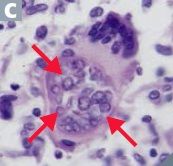
-Biopsy shows endospores inside spherules.
|
|
|
Coccidioides immitis: Clinical symptoms
|
-Erythema nodosum
-Pneumonitis -Arthralgias -AIDS patients; meningitis, mucocutaneous lesion -Can disseminate in the third trimester |
|
|
Histoplasma capsulatum: Characteristics
|
-No person-person transmisison
-Mississippi/Ohio River valleys -Bird or bat droppings (common in cave exploration and in chicken farmers) |
|
|
Histoplasma capsulatum: Pathogenesis
|
-Reservoir; soil and animal droppings (birds/bats)
-Transmission; inhalation -Macrophages phagocytose and carry spores systemically -Budding yeast in macrophages causes local infection -Infections are within granulomas and calcify |
|
|
Histoplasma capsulatum: Clinical symptoms
|
-No symptoms in healthy patients
-Systemic infections in immunocompromised patients -Pneumonaitis similar to milliary TB -May involve liver, spleen and adrenals in immunocompromised patients |
|
|
Histoplasma capsulatum: Diagnosis
|

-Granulomas
-Calcified lung lesions -Small budding cells withing macrophages on biopsy -Spherules |
|
|
Blastomyces dermatitidis:
|
-East coast of the U.S., Upper Great Lakes, Canada and Mexico
-Rarest of all systemic mycoses |
|
|
Blastomyces dermatitidis: Pathogenesis
|
-Reservoir; soil, rotten wood containing spores
-Transmission; Inhalation of spores, then form yeast in the body |
|
|
Blastomyces dermatitidis: Clinical symptoms
|
-Pneumonitis
-Arthritis -Granulomas -Disseminates from lung to skin (DERMatitidis) |
|
|
Blastomyces dermatitidis: Diagnosis
|
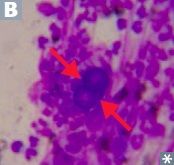
-Granulomas
-Lung lesions do NOT calcify -Broad Based Budding Blastomyces |
|
|
Paracoccidiodes: Characteristics
|
-Latin America
-Budding yeast with "captain's wheel" formation |
|
|
Paracoccidiodes: Pathogenesis
|
-Reservoir; spores in soil
-Transmission; Inhalation of spores |
|
|
Paracoccidiodes: Clinical symptoms
|
-Similar to Coccidiodes
|
|
|
Paracoccidiodes: Diagnosis
|
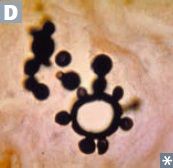
-Multiple buds, like a "pilot's wheel"
|
|
|
Opportunistic
|
-Candida albicans
-Cryptococcus neoformans -Pneumocystis carinni -Aspergillus fumigatus -Mucor rhizopus -Pneumocystis jirovec |
|
|
Candida albicans: Characteristics
|
-Natural skin flora
-Common cause of yeast/skin infections in immunocompromised patients |
|
|
Candida albicans: Pathogenesis
|

-Reservoir; GI flora, mucous membrane and normal skin flora in moist areas
-Growth; Forms pseudo/true hyphae when invading tissue |
|
|
Candida albicans: Clinical symptoms
|
-Healthy host; oral thrush, vaginitis (diabetic women) and diaper rash
-Immunocompromised host; esophagiitis, cutaneous infection, systemic infection and septicemia and endocarditis in IV drug users |
|
|
Candida albicans: Diagnosis
|
-Silver stain
-KOH stain for pseudohyphae and budding yeast -"Cottage cheese like discharge" -Germ tube formation |
|
|
Cryptococcus neoformans: Characteristics
|

-Affects AIDS and SLE patients and those with poor T-cell mediated immunity
-Encapsulated |
|
|
Cryptococcus neoformans: Pathogenesis
|
-Reservoir; Pigeon and bird droppings
-Transmission; Inhalation of yeast from droppings, leads to lung infection -Spreads via blood to CNS |
|
|
Cryptococcus neoformans: Clinical symptoms
|
-Pneumonia
-Fungemia -Meningitis; forms abscesses and increases intracranial pressure (MOST COMMON cause of meningitis in AIDS patients) |
|
|
Cryptococcus neoformans: Diagnosis
|
-"Soap bubble lesions"
-Budding yeast on India ink -Urease-positive |
|
|
Pneumocystitis jiroveci: Characteristics
|
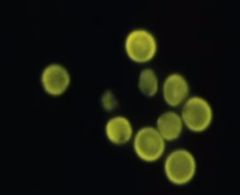
-Frequently affects AIDS patients
-Also may affect premature infants -Dented or "condom shaped" |
|
|
Pneumocystitis jiroveci: Pathogenesis
|
-Transmission; Inhalation of cyst
|
|
|
Pneumocystitis jiroveci: Clinical symptoms
|
-Pneumonia in AIDS patients (CD4+ count below 50)
-cough, fever, SOB -leading cause of death in AIDS patients -May cause pneumothorax -Occurs more in immunocompromised hosts |
|
|
Pneumocystitis jiroveci: Diagnosis
|
-Silver stain showing cysts containing dark oval bodies
|
|
|
Aspergillus fumigatus: Characteristics
|
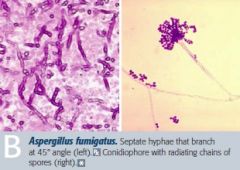
-Fruiting bodies at ends of hyphae
-Affects neutropenic patients |
|
|
Aspergillus fumigatus: Pathogenesis
|
-Reservoir; mold grows in decaying vegetation (wheat stacks)
-Transmission; Inhalation of spores |
|
|
Aspergillus fumigatus: Clinical symptoms
|
-Various lung diseases
-Allergic bronchopulmonary aspergillosis -Aspergillous ball; aspergilloma (preformed lung cavities -Acute/chronic pneumonitis (often with hemoptysis) -Invasive Aspergillosis (severe neutropenia or burns); causes MI, hemorrhage, pneumonia or meningitis |
|
|
Aspergillus fumigatus: Diagnosis
|
-Biopsy reveals branching hyphae (45 degrees) with septate hyphae (hyphae are divided)
-Sputum culture shows radiating chains of spores -Possible aspergilloma on X-ray |
|
|
Rhizopus mucor: Characteristics
|
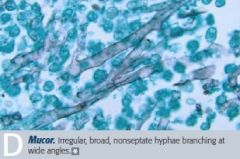
-Afflicts diabetics and leukemia patients
|
|
|
Rhizopus mucor: Pathogenesis
|
-Reservoir; spores
-Transmission; Inhalation of spores -In immunocompromised hosts, it colonizes tissue and invades blood vessels, leading to necrosis |
|
|
Rhizopus mucor: Clinical symptoms
|
-Rhinocerebral infection
-Pneumonitis similar to Aspergillus -Lethal |
|
|
Rhizopus mucor: Diagnosis
|
-Biopsy shows branching hyphae (90 degrees) without septate
-Shows broad ribbon-like growth pattern -"Black pus" |
|
|
Cutaneous
|
-Microsporum
-Malessezia furfur |
|
|
Microsporum: Characteristics
|
-Includes multiple types of fungi that infect skin
-Trichophyton and Epidermophyton affects nails -Tichophyton mentagrophytes affects feet |
|
|
Microsporum: Pathogenesis
|
-Reservoir; soil, animals and humans
-Transmission; Spread by contact with an infect host -Colonizes keratinized epithelium -Infection spreads in centrifugally ("ringworm" -Antigens may induce delayed type hypersensitivity |
|
|
Microsporum: Clinical symptoms
|
-Ringworm (tinea corporis); ring lesion on the skin
-Athlete's foot (tinea pedis) -Jock itch (tinea cruris) -Oncomycoses (tinea unguium); nail infection -Body infection (tenia corporis) |
|
|
Microsporum: Diagnosis
|
-Skin scrapings allow keratin to be removed
-Hyphae can be observed on KOH prep -Wood's lamp (UV) detects Microporum |
|
|
Malessezia Furfur: Pathogenesis
|
-Reservoir; animals, humans, soil
-Transmission; contact -Common for those who consistently work outdoors |
|
|
Malessezia Furfur: Clinical symptoms
|
-Pityriasis or tinea versicolor: Pale spots on the skin, often on the back
|
|
|
Malessezia Furfur: Diagnosis
|

-KOH prep "spaghetti and meatballs"
-Short, unbranched hyphae -Spherical yeast |
|
|
Sporothrix shenckii: Characteristics
|
-Subcutaneous
|
|
|
Sporothrix shenckii: Pathogenesis
|
-Reservoir; spores in soil
-Transmission; spores enter via cuts and puncture wounds (puncture from rose thorn) |
|
|
Sporothrix shenckii: Clinical symptoms
|
-Sporotrichosis ("Rose-gardener disease")
-Slow local infection forms primary nodules that becomes necrotic and ulcerates -Secondary nodules can form along lymphatics while they drain a primary infection; appear in the upper extremity that was infected via break in the skin -Pulmonary infection ("alcoholic-rose gardener disease") |
|
|
Sporothrix shenckii: Diagnosis
|

-Produces black pigment
-Shape changes with change in culture temp -Branched hyphae at 25 deg C -Single cells (cigar-shaped budding yeast) at 37 deg C |

